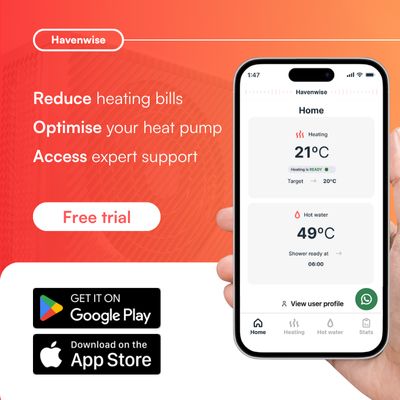Cosy Octopus and heat pump settings
Hi folks,
A quick question I thought I'd canvas opinion on:
We're on our very first day of the Cosy Octopus Tariff, and certainly at this outdoor temperature (1-5°C today) it looks like it's worked well for us. I scheduled our Vaillant AroTherm Plus to do all its DHW runs during the cheap periods (remains to be seen whether this is quite sufficient - will have to poll the shower users!) and also boosted the indoor target temperature to 20°C in the afternoon cheap period before dropping to the 18°C setback to coast across the peak period.
Worked pretty well. On this particular day/temps, no HP usage at all in the peak period, and a reasonable amount shifting into the cheap periods. I calculate a 21.6% cost saving on heating/hot water today compared to the base rate, solely using the house as a heat store. (No battery yet; hopefully coming in January). I did notice, though, that the house temp did not reach the 20°C target in the three hour cheap window before switching off for the peak time (it would get there if I let it run longer).
So, while I know that generally lowering the heat curve is a good plan for efficiency (and is what I have targeted up until now), it seems to me that on a cost basis, there is a fairly solid argument for bumping the heat curve back up again somewhat in order to make best use of the TOU tariff. (On a similar basis, there is also a disincentive to run the DHW on eco mode to maximise efficiency.) Do you agree? Have you tried similar strategy? Or something else?
(Ideally, one might want to have different heat curves set for the cheap periods than for the rest of the day, but life's too short to manually adjust several times every day!)
Cheers,
Jo
Hi Jo. I've been on Cosy a few weeks now and, like you, have been wondering about this. I've got 10kWh worth of batteries so that is really helping me take advantage of the tariff. A full battery by 1600hrs means I can coast through the peak on all but the coldest days.
My DHW is timed twice a day to coincide with cosy time but really it's not a big demand (in relation to heating) so I don't concern myself too much with it.
With the heating, I did briefly try cosy time boosts and set-backs during peak but found (a) the house was slow to warm up, particularly in very cold conditions and (b) it just felt more comfortable with the heating purring away 'low and slow' at a stable temperature. There's also less manual tweeking and, as you say, life's too short. I don't want to be adjusting LWT offsets up and down several times each day. I've not gone down the Homely route to automate this but that might be an option one day.
I can't point to data to say precisely which is more economical but my impression is there's not much in it.
Regards
Simon
2 x 12kW Samsung Gen6 ASHP, 5.6kW solar PV ground mounted c/w 10kWh Puredrive battery & Solis inverter.
We have been on Cosy for a few weeks now and have the advantage of 27 kW/h of storage; this has meant that we only use the 6 cheapest Cosy hours each day. We have also recently had Homely fitted and this seems to be working well. Homely have configurations for TOU tariffs but really for us, this doesn’t really matter a great deal. Unless we wish to make the very most of the 6 hours to not only charge the battery but also ‘boost’ the ASHP output so that those 6 hours are straight from the grid (without the 10% round trip losses when via the battery). At present, Evergreen Energy have not written Cosy into the app’s TOU list so I have toggled Smart+ off as if it Homely tries to do anything clever with TOU settings, they won’t do anything for our setup. Our system has a 1 degree setback during the night but otherwise, it is constant temperature setting the rest of the time 24/7. At present, there is the additional consideration of the OE Saving Sessions so we make sure we have a few kW/h to export during such sessions ‘to help out’. Regards, Toodles.
Toodles, heats his home with cold draughts and cooks food with magnets.
I'm on Intelligent rather than Cosy, but I have automated my heat pump to boost the flow temp by 5C during the cheap period. I don't think it's game changing but I do it anyway because why not? If i was on cosy I'd definitely do what you're doing, boost during cheap period then coast during peak. We actually do this for the saving sessions, which has been quite lucrative for us.
The other thing to consider is that the cheap cosy period in the afternoon coincides with the warmest part of the day, so boosting the flow temp during the time means the heat pump is working hardest when it's easiest to pump the heat.
ASHP: Mitsubishi Ecodan 8.5kW
PV: 5.2kWp
Battery: 8.2kWh
Posted by: @dunlornit just felt more comfortable with the heating purring away 'low and slow' at a stable temperature.
That's interesting. In our house our comfort preferences specified the opposite: small setback overnight because otherwise it was too warm at night when everyone's tucked up, plus it adds the nice perceived warmth in the morning as the radiators are more obviously on! And pretty sure it's cheaper overall due to the lower temp overnight.
Good point on heating at the best time of day.
On the savings sessions, I've tried one, which didn't really work - our smart meter seems to be only temperamentally smart - plus I suspect we don't have enough history for them to make an informed judgement of our average use. Which makes me wonder: given that the saving sessions are generally within the peak period when our heating is off (coasting), our average at that time will be minimal, so we probably wouldn't make anything much on a saving session.
Next conjecture: thinking about it some more with the aid of the heat curve diagrams, mucking about with the heat curves is probably far less effective than simply bumping up the temp by a degree during our "heat charging" sessions. Brings up the flow temp by around 5°C per degree of target temp.
Next question: this morning it didn't top up the DHW tank, as the measured tank temp hadn't dropped far enough. But we really need a full tank for the morning showers. So how can I force it to top up? Don't want to (wake up at 4am and) manually boost it. Given that I have it scheduled for the cheap periods only, should I just tighten up the hysteresis as much as possible, so it has the highest chance of triggering? Does that seem like a plausible solution?
Cheers,
Jo
Hi @josephiah. I do use night time set backs in the shoulder season as it's a little warmer and everything can react quickly enough. I use a higher WC curve as well, for intermittent operation. Once it gets too cold, around end Nov, I switch to a lower curve and low&slow continuous mode. I use the offsets for the occasional lift, eg if it's windy outside and the house is losing more heat. Still learning though!
Like you, I make very little on the saving sessions but it seems that you get a few points for joining in so I'm doing it.
I've been caught out with no hot water in the morning once or twice. I extended my scheduled on period for the entire Cosy period (initially I'd set it just for 1hr from 0400) and that helped but really I think it's about knowing what works with your pattern of use.
2 x 12kW Samsung Gen6 ASHP, 5.6kW solar PV ground mounted c/w 10kWh Puredrive battery & Solis inverter.
Posted by: @josephiahNext question: this morning it didn't top up the DHW tank, as the measured tank temp hadn't dropped far enough. But we really need a full tank for the morning showers. So how can I force it to top up? Don't want to (wake up at 4am and) manually boost it. Given that I have it scheduled for the cheap periods only, should I just tighten up the hysteresis as much as possible, so it has the highest chance of triggering? Does that seem like a plausible solution?
Cheers,
Jo
You could try increasing the tank target temperature so that, even if it's 3C below and doesn't trigger, it's still hot enough for long enough to supply your showers. Obviously this will make it more expensive to heat up, so that's the trade off.
You could also look into automation that will "automatically" trigger the "manual" DHW heating. This is possible on my Mitsubishi Ecodan heat pump, but not officially supported.
ASHP: Mitsubishi Ecodan 8.5kW
PV: 5.2kWp
Battery: 8.2kWh
Posted by: @josephiah(No battery yet; hopefully coming in January)
Hold fire until Feb if you can Jo as you'll get much lower VAT on batteries added to solar PV systems from then. Before then you'll have to pay full 20% VAT.
DHW - if you have a newish tank of adequate capacity, the best time of day on Cosy to charge this is early afternoon. I use 1-2:15pm on COSY cheap rate. The daytime temperature is highest then, so lower chance of defrost cycle mid cylinder charge, and also better COP than the morning 4am-7am low rate period. That's about the worst time to generate DHW using an ASHP as the temperature is colder and relative humidity higher. We find with a 250l pre-plumb cylinder charged to 55degC we've ample hot water next morning for 3x showers. Depends on how much DHW you use of course.
Posted by: @scrchngwslYou could try increasing the tank target temperature so that, even if it's 3C below and doesn't trigger, it's still hot enough for long enough to supply your showers. Obviously this will make it more expensive to heat up, so that's the trade off.
Hmm, not sure about that - I think that would just shift the overall temperature up. The thing that triggers a reheat is dropping a certain amount relative to the target temp, rather than hitting an absolute value. So I suspect the tightening the hysteresis band is probably the best bet here, barring more complex automation approaches. Will investigate.
@allyfish battery VAT: thanks for the reminder, however, ours will be part of a PV install, so I think there's no difference in our case.
High DHW use in our household of seven! So we usually run through at least a 300l tank a day, sometimes twice over.
600 litres! Ouch!!!
On the VAT, in case it is of interest to anyone; it is a less than well advertised fact that anyone over 60 yoa purchasing batteries can do so at a VAT rate of 5% rather than 20% - obviously still better to purchase as part of a renewable equipment package and pay 0% VAT of course! (I have done this) Regards, Toodles
Toodles, heats his home with cold draughts and cooks food with magnets.
Posted by: @toodles600 litres! Ouch!!!
On the VAT, in case it is of interest to anyone; it is a less than well advertised fact that anyone over 60 yoa purchasing batteries can do so at a VAT rate of 5% rather than 20% - obviously still better to purchase as part of a renewable equipment package and pay 0% VAT of course! (I have done this) Regards, Toodles
Where is this information hidden? Does it only apply if fitted by an installer?
- 26 Forums
- 2,338 Topics
- 52.8 K Posts
- 225 Online
- 5,994 Members
Join Us!
Podcast Picks
Latest Posts
-
RE: Grant Aerona Short Cycling
@damonc, thanks for confirming that detail, really help...
By Steam Powered , 15 minutes ago
-
RE: What a Bad Heat Pump Installation Looks Like
Quite possible no grant involved so none. Putting it ...
By JamesPa , 58 minutes ago
-
RE: Aira Heat Pump: Stylish Scandinavian Heating
Thanks @gmuzz @mikeh They still mention on the app t...
By ChandyKris , 2 hours ago
-
RE: Experience with Mitsu Par 50/60 Wireless Controller
The 27°C request doesn't boost the weather compensation...
By Sheriff Fatman , 18 hours ago
-
RE: Getting the best out of a heat pump - is Homely a possible answer?
Oh and it was installed by Stevie Wonder!
By Grantmethestrength , 20 hours ago
-
There seems to be plenty of evidence to support this. ...
By JamesPa , 1 day ago
-
RE: One Year Review: Grant 13kW ASHP - A Catalogue of Errors
@solenoid it sounds like you are making progress. No n...
By JamesPa , 1 day ago
-

RE: LiFePO4 lithium battery fires and explosions
@iaack — thanks, a useful video. They do make it clear...
By cathodeRay , 1 day ago
-
RE: How good is the app support for your heat pump?
I think you are right about the ebus stick. It's cert...
By JamesPa , 2 days ago
-

RE: My DIY Heat Pump installation
@majordennisbloodnok Element-ary my Dear Major.
By Toodles , 2 days ago
-
RE: Replacing my 18 month old Hitachi Yutaki ASHP
Yes, you can work out a lot from a plot of FT. Interes...
By JamesPa , 2 days ago
-

Welcome to the forums @isaac. What you’re describing is...
By Mars , 2 days ago
-

Win an Eve Smart Home Bundle worth over £350!
Win an Eve Smart Home Bundle worth over £350! ...
By Mars , 2 days ago
-
RE: Is your heat pump insured?
I chose Tesco in the end. Unambiguously cover HP, PV an...
By Davesoa , 2 days ago
-
RE: Help me keep the faith with my air source heat pump installation
@adamk You can get an idea of if your flow and return...
By SimonF , 2 days ago
-
This Solis inverter being rated 8kw and (I expect, as I...
By Batpred , 3 days ago
-
RE: A2A vs A2W: Which Heat Pump Would You Pick?
I have one fancoil in an otherwise all radiator system....
By JamesPa , 3 days ago
-

RE: Electricity price predictions
That's understandable...but I was referring to our 'oth...
By Transparent , 3 days ago





